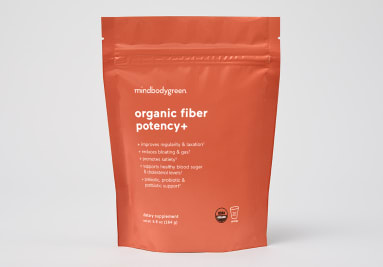5 Morning Habits That Can Curb Late-Night Cravings, According To RDs
One of them even includes eating dessert.


Registered Dietitian Nutritionist
Registered Dietitian Nutritionist
Molly Knudsen, M.S., RDN is a Registered Dietician Nutritionist with a bachelor’s degree in nutrition from Texas Christian University and a master’s in nutrition interventions, communication, and behavior change from Tufts University. She lives in Newport Beach, California, and enjoys connecting people to the food they eat and how it influences health and wellbeing.
Image by Valeriy_G / iStock August 22, 2023 So, you’ve made it through an entire day. And now well into your evening—even after dinner—is when the cravings set in. It could be something to quell a sweet tooth or satisfy a crunchy palate. While there’s nothing wrong with having snacks and desserts, it’s usually the time of day and missing mindfulness that makes this habit one to kick. Not only is eating late at night linked with poorer measures of metabolic health, but it could mean that something is off or lacking during your daytime routine. And curbing late-night snacking actually starts when you wake up. 
Advertisement
This ad is displayed using third party content and we do not control its accessibility features.
We tapped into two registered dietitians for their best tips on morning habits to help keep you satisfied during the day (and out of the pantry before bed). 1. “The first thing I often recommend to keep evening cravings at bay is to remain consistent with other meals throughout the day,” says Maeson Temple, RDN, L.D., CNSC. “Making sure to eat breakfast, lunch, and dinner (or even an afternoon snack) will prevent an increased appetite later in the evening.” Days fill up quickly, and making time to eat a meal (let alone a balanced meal) can be challenging. Add on stressful situations, and those hormones may be enough to squash the desire for food1. Your appetite may tick up again once you’ve had a moment to breathe in the evening, which could have you reaching for convenient, but high-calorie foods. “When meals are skipped early in the day, some people feel an instinctual need to ‘make up for’ nutrients or calories missed earlier in the day, creating more cravings at night that seem out of balance,” notes Temple. Hubert even warns, “Don't try to eat as little as possible... it usually will lead to sabotaging you!” 2. Not only is the consistency of meals important, but so is the makeup of those dishes. “A lot of times we end up overeating late at night because we simply just aren't eating right earlier in the day,” emphasizes Lauren Hubert, M.S., R.D. That means eating balanced meals with plenty of protein and color on your plate.” And most people are consistently falling short on protein in particular. Protein has some powerfully satiating qualities2. The absolute minimum protein recommendation for healthy adults is 0.8 grams per kilogram of body weight a day. For someone weighing 150 pounds, that's about 55 grams daily. But for optimal health and especially for building muscle that recommendation bumps up to about 1.4 to 2.0 grams per kilogram body weight a day (equaling 109-150 grams of protein for that 150-pound person). To simplify this math, Hubert recommends eating at least 20 grams of protein each meal while some folks may need closer to 30-40 grams depending on how much they exercise. Her favorite, easy protein sources include chicken breast, ground turkey, fish, greek yogurt, tofu/soy products, and eggs (with extra egg whites). This ad is displayed using third party content and we do not control its accessibility features. 3. Fiber is another filling ingredient that about 95% of people 3aren’t meeting the daily recommendation of 19-38 grams (depending on age and sex). Fiber is a non-digestible part of carbohydrate foods (like whole grains, fruits, and vegetables). It adds volume to the gut aka “bulk” to the gut that can make you physically feel full. And while we don’t digest fibers, our gut microbes do. Soluble, prebiotic fibers feed the good bacteria residing in the gut microbiome that in turn produce beneficial short-chain fatty acids (SCFA). The fermentation of guar bean fiber in particular produces more of the SCFA butyrate—which plays an important part in satiety hormone synthesis4—compared to other fibers.* mindbodygreen’s organic fiber potency+ provides an impressive six grams of fiber (mainly from guar beans) in each serving. The flavorless organic powder easily mixes with water, in oatmeal, smoothies, and even yogurt to conveniently enhance the fiber content of any meal and snack. Whether eaten fresh or in a supplement powder—like mbg's organic fiber potency+—guar beans are a good source of soluble fiber to support healthy butyrate production and appetite regulation.* This ad is displayed using third party content and we do not control its accessibility features. Sometimes, cravings are also your body’s way of trying to tell you something and indicate a need for certain nutrients. “Unfortunately, wires can get crossed and the body signaling a need for more glucose [sugar] can feel like a need to reach into the candy jar at night instead of trying some fruit or whole grain toast, and other whole food items that will provide glucose to the body,” says Temple. Carbohydrate foods still often have a bad rap for promoting cravings or weight gain, and that's not the case—especially for complex, fiber-rich carbs. 5. And lastly, just changing up the timing of your dessert can help. “I notice people tend to crave foods they consider ‘bad’ and that they try to avoid,” says Hubert. “So when they get low blood sugar or they have that food in front of them, they cannot control themselves and end up overeating far more than if they mindfully included it in their diet consistently.” The solution? Consider making your treat (it could be a salty or crunchy one) into your regular daytime routine. If you have dessert after lunch, the protein and fiber from your meal should help keep your blood sugar levels from spiking and leave you full and satisfied until your next meal. And the lack of hunger from eating consistent, balanced meals and snacks allows you to be more cognizant of the serving size of your treat—so you can have enough to please your taste buds while not overindulging. This ad is displayed using third party content and we do not control its accessibility features.Stay consistent with meals (& snacks) throughout the day
Be intentional about your portion sizes — especially for protein
Advertisement
Bump up your fiber intake
Advertisement
Incorporate a sweet treat earlier in the day
Advertisement
The takeaway
Late-night snackiness often results from something going amiss in your diet during the day. Curbing these cravings really boils down to eating balanced meals and snacks—prioritizing protein and fiber—to keep your hunger at bay and your blood sugar balanced. Check out these tasty recipes for inspo for high-protein snacks and our favorite high-fiber products here.

 FrankLin
FrankLin 






























